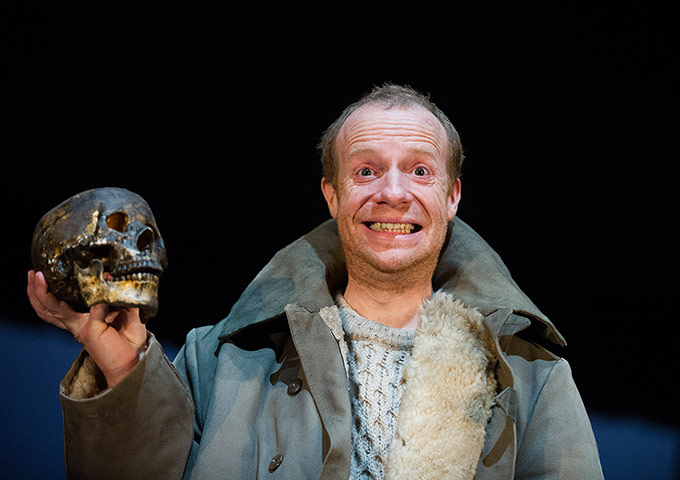On Friday, November 17th, more than 60 Shakespeare students, scholars, theatre practitioners, and enthusiasts gathered at the Royal Shakespeare Company’s Other Place Theatre in Stratford-upon-Avon to discuss emotion in Shakespeare’s plays. This educational event, called ‘Shakespeare’s Emotions, Lost and Found’, was aimed at A-level students and university undergraduates and formed part of the nationwide Being Human Festival, which ran from 17-25 November and showcased research in the humanities in more than 45 UK cities and towns. In Stratford, ‘Shakespeare’s Emotions’ was organized and supported by the collaboration between the RSC and the University of Birmingham, with further support from the British Shakespeare Association.

The event began with a half-hour panel chaired by Dr Daisy Murray and featuring academics associated with the University of Birmingham and theatre practitioners and audience analysts from the RSC. Dr Erin Sullivan and Dr Kerry Cooke spoke about understandings of emotion in Shakespeare’s time, as well as the ways in which performing the plays on stage creates a complex emotional relationship between performers, characters, audiences, and text. Matt Dann and Esh Alladi, both part of the RSC’s current production of Twelfth Night, in turn reflected on the role of emotion in the rehearsal room and the kinds of emotional journeys actors experience as they acquaint themselves with a new role. Becky Loftus, Head of Audience Insight at the RSC, finished things off by speaking about a study that the theatre conducted into audiences’ emotional responses to live theatre, cinema broadcasts of theatre, and 360° VR theatre (more on that study available here).
Thinking about the differences and similarities between ideas about emotion in the past and present proved especially interesting for many participants, with one university undergraduate commenting that she ‘enjoyed hearing about the historical context, which created another way of looking at Shakespeare’. Likewise, a university postgraduate noted that ‘the panel’s discussion of the perception of emotion in the early modern period [was] very interesting. I spend a good deal of time reading the modern scientific papers on emotion in voice and visual communication, so to compare those ideas with the idea of the four humors was intriguing.’

In the second half-hour, the audience broke into small groups and looked at a selection of emotional passages from Shakespeare chosen by each member of the panel. Each group was led by a PhD student in Shakespeare studies who served as a discussion facilitator, inviting participants to talk through the emotional experiences, ideas, metaphors, and scenarios depicted in their passage. For many audience members, the chance to become actively involved in small-group discussion was a particular highlight: ‘working in small groups to further discuss emotions as well as listening to other people’s ideas’ was especially enriching, one A-level student commented, while an undergraduate reflected on how the ‘opportunity to read an extract in group work before and after our analytical discussion’ encouraged him to think more deeply about ‘how dialogue changed with added knowledge of its context’.
Attendees at the event weren’t the only ones who found the small-group discussions beneficial. The five PhD facilitators, whose involvement was made possible by a British Shakespeare Association small event award, spoke afterwards how the event helped them develop new ideas and skills: ‘Participating in the “Shakespeare’s Emotions: Lost and Found” event gave me practical and valuable experience in a teaching setting’; ‘It showed me that preparation is invaluable, and it was lovely working with a young group of students who had very creative and intelligent responses to the text’; ‘I was very pleased by the group’s happy surprise that our quite challenging passage had, in the course of the discussion, suddenly become not only intelligible but even emotionally resonant’; ‘Several students even stopped me on the way out to ask further questions and share more ideas’. The event offered these early career scholars the chance to develop their teaching and public engagement skills and to work with Shakespeare enthusiasts from a range of different backgrounds.

In the final half-hour of the session, representatives from each of the small groups and the opening panellists finished with short presentations and whole-group discussion about the varied role of emotion in Shakespeare. Students highlighted key ideas discussed in relation to their passages, including the way specific words and images help shape emotion, the way performance turns emotion into a very social and at times tense event, and how historical differences in ideas about emotion can give us new insights into how culture shapes human experience. As the event came to a close, many participants hurried off to grab a quick dinner and then to take their seat for the RSC’s evening performance of Twelfth Night – no doubt resulting in even more emotional experiences and ideas after an already very passionate afternoon!









